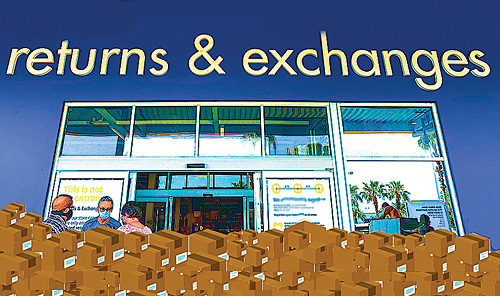Front Line: Reverse Logistics Opportunities, Challenges
As online sales have surged so have purchase returns, resulting in reverse logistics challenges for shippers.
Q1 2021

As these factors continue to grow, Kris Bjorson, international director of Industrial Brokerage and Retail/E-Commerce Distribution manager at JLL, told Area Development that demand for warehousing space will top one billion square feet. Melinda McLaughlin, vice president and global head of Research at Prologis pointed out to us that online order fulfillment requires more than three times the logistics space of brick-and-mortar sales because 100 percent of inventory is stored within a warehouse, versus on store shelves. “This translates into greater product variety, deeper inventory levels, and space-intensive parcel shipping operations,” she says. “Processing returns contributes to that ratio, as goods returned by a customer are not palletized and, therefore, take a lot of space — and this storage usually occurs inside a warehouse.”
CBRE also estimated in its report that for the average return, reverse logistics costs amount to 59 percent of the original sales price of the item.
“This is why you see some companies allowing consumers to keep the goods instead of returning them,” says McLaughlin. “Also, with logistics real estate in short supply, and demand for logistics talent at an all-time high, companies have found reverse logistics to be space- and labor-intensive as items are processed piece by piece.”
Optoro, a Washington, D.C.-based returns technology software provider, reports in the CBRE study that reverse logistics functions require an average of up to 20 percent more space and labor capacity compared to forward logistics. Consequently, reverse logistics is now a major driver for industrial real estate, says Matt Walaszek, associate director of Industrial & Logistics Research at CBRE and author of the report. He expects this demand to continue to grow: “More forward orders mean more inventory is coming back, increasing space demand especially during the holiday season.”
Reverse logistics costs amount to 59 percent of the original sales price of the item. JLL’s Bjorson estimates that as a result, probably 7.5 percent or 75 million square feet may have some application to reverse logistics. “We are noticing that depending on the path of the return, the policy and procedures implemented at the retail level don’t always translate to the industrial warehouse level,” he notes. “Another challenge is not having the technology advancements for shippers to enable early decision-making on returns.”
E-commerce growth is already resulting in an additional 1.5 billion square feet of industrial space entering the marketplace over the next five years, CBRE projects. Walaszek expects that as upgrades are made to newly constructed buildings, those involved in reverse logistics will have access to leasing more Class B space.
“Typically, second-generation space is preferred over modern Class A facilities,” says Walaszek. “Lower ceiling heights are more appropriate since the activities within the space are high-touch with slower processing, and the varying size of the pallet loads makes them difficult to stack or safely store in high racks.”
But finding such space varies from market to market. CBRE reports the Q4 2020 vacancy rate for the overall industrial market at 4.6 percent, with 3.9 percent for non-Class A buildings. This means locating desired space to accommodate reverse logistics activities will be extremely difficult to find, Walaszek says.
Logic would suggest that lower-rent regions in the Central States would be prime for accommodating reverse logistics functions. “But reverse logistics is very seasonal. Holding that much dedicated space year-round doesn’t make sense unless the operators have dedicated their business to reverse logistics,” Walaszek explains. “Even liquidators, whose year-round reverse logistics activities have primarily been centrally located, are now considering bifurcating single site businesses into East/West regional sites.”
Project Announcements
Ohio Lumex Expands Solon, Ohio, Operations
12/26/2025
Calgon Carbon Corporation Expands Pittsburgh, Pennsylvania, Operations
12/25/2025
Cascades Expands Eau Claire, Wisconsin, Operations
12/25/2025
P.C. Campana Plans Vicksburg, Mississippi, Production Operations
12/25/2025
Midwest Equipment Manufacturing Expands Maysville, Kentucky, Operations
12/25/2025
Stord Expands Hebron, Kentucky, Warehouse Operations
12/25/2025
Most Read
-
The Workforce Bottleneck in America’s Manufacturing Revival
Q4 2025
-
Rethinking Local Governments Through Consolidation and Choice
Q3 2025
-
Lead with Facts, Land the Deal
Q3 2025
-
Tariff Shockwaves Hit the Industrial Sector
Q4 2025
-
Investors Seek Shelter in Food-Focused Real Estate
Q3 2025
-
America’s Aerospace Reboot
Q3 2025
-
The Permit Puzzle and the Path to Groundbreaking
Q3 2025



